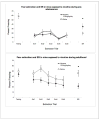Chronic nicotine exposure in preadolescence enhances later spontaneous recovery of fear memory
- PMID: 29975080
- PMCID: PMC6095659
- DOI: 10.1037/bne0000247
Chronic nicotine exposure in preadolescence enhances later spontaneous recovery of fear memory
Abstract
Preadolescent mice have been shown to be differentially susceptible to the effects of both acute and chronic nicotine exposure on contextual fear learning relative to adults. For this study, we tested the effects of chronic nicotine exposure in preadolescence on adulthood extinction and spontaneous recovery of fear memory in a model in which contextual fear acquisition occurred prior to nicotine exposure. Preadolescent (postnatal day 23) and adult (postnatal day 53) male C57BL/6J mice underwent contextual fear conditioning and were then exposed to chronic nicotine at 12.6 mg/kg/day for 12 days via osmotic minipump. Eighteen days following the removal of nicotine, both groups of mice underwent fear extinction, followed by a spontaneous recovery session a week later. History of chronic nicotine did not affect later extinction of fear memory in adult-trained mice, whereas adolescent-trained mice exhibited a global impairment in retention of fear memory that precluded detection of effects of early nicotine on later fear extinction. However, it was found that adult spontaneous recovery of fear memory was impaired in mice exposed to nicotine as adults and enhanced in mice exposed to nicotine as preadolescents. These results may indicate greater vulnerability to recurrence of traumatic memory as well as compromised inhibitory control in young smokers. (PsycINFO Database Record
(c) 2018 APA, all rights reserved).
Figures



Similar articles
-
Sex differences in contextual fear conditioning and extinction after acute and chronic nicotine treatment.Biol Sex Differ. 2024 Oct 31;15(1):88. doi: 10.1186/s13293-024-00656-6. Biol Sex Differ. 2024. PMID: 39482781 Free PMC article.
-
Pre-adolescent and adolescent mice are less sensitive to the effects of acute nicotine on extinction and spontaneous recovery.Brain Res Bull. 2018 Apr;138:50-55. doi: 10.1016/j.brainresbull.2017.06.010. Epub 2017 Jun 15. Brain Res Bull. 2018. PMID: 28624583 Free PMC article.
-
Acute nicotine delays extinction of contextual fear in mice.Behav Brain Res. 2014 Apr 15;263:133-7. doi: 10.1016/j.bbr.2014.01.031. Epub 2014 Jan 31. Behav Brain Res. 2014. PMID: 24487010 Free PMC article.
-
Learning and memory in conditioned fear extinction: effects of D-cycloserine.Acta Psychol (Amst). 2008 Mar;127(3):601-13. doi: 10.1016/j.actpsy.2007.07.001. Epub 2007 Aug 17. Acta Psychol (Amst). 2008. PMID: 17707326 Review.
-
Substance abuse, memory, and post-traumatic stress disorder.Neurobiol Learn Mem. 2014 Jul;112:87-100. doi: 10.1016/j.nlm.2013.12.002. Epub 2013 Dec 15. Neurobiol Learn Mem. 2014. PMID: 24345414 Free PMC article. Review.
References
-
- Baker KD, Den ML, Graham BM, Richardson R. A window of vulnerability: Impaired fear extinction in adolescence. Neurobiology of learning and memory. 2014;113:90–100. - PubMed
-
- Counotte DS, Spijker S, Van de Burgwal LH, Hogenboom F, Schoffelmeer AN, De Vries TJ, … Pattij T. Long-lasting cognitive deficits resulting from adolescent nicotine exposure in rats. Neuropsychopharmacology. 2009;34(2):299. - PubMed
MeSH terms
Substances
Grants and funding
LinkOut - more resources
Full Text Sources
Other Literature Sources
Medical

